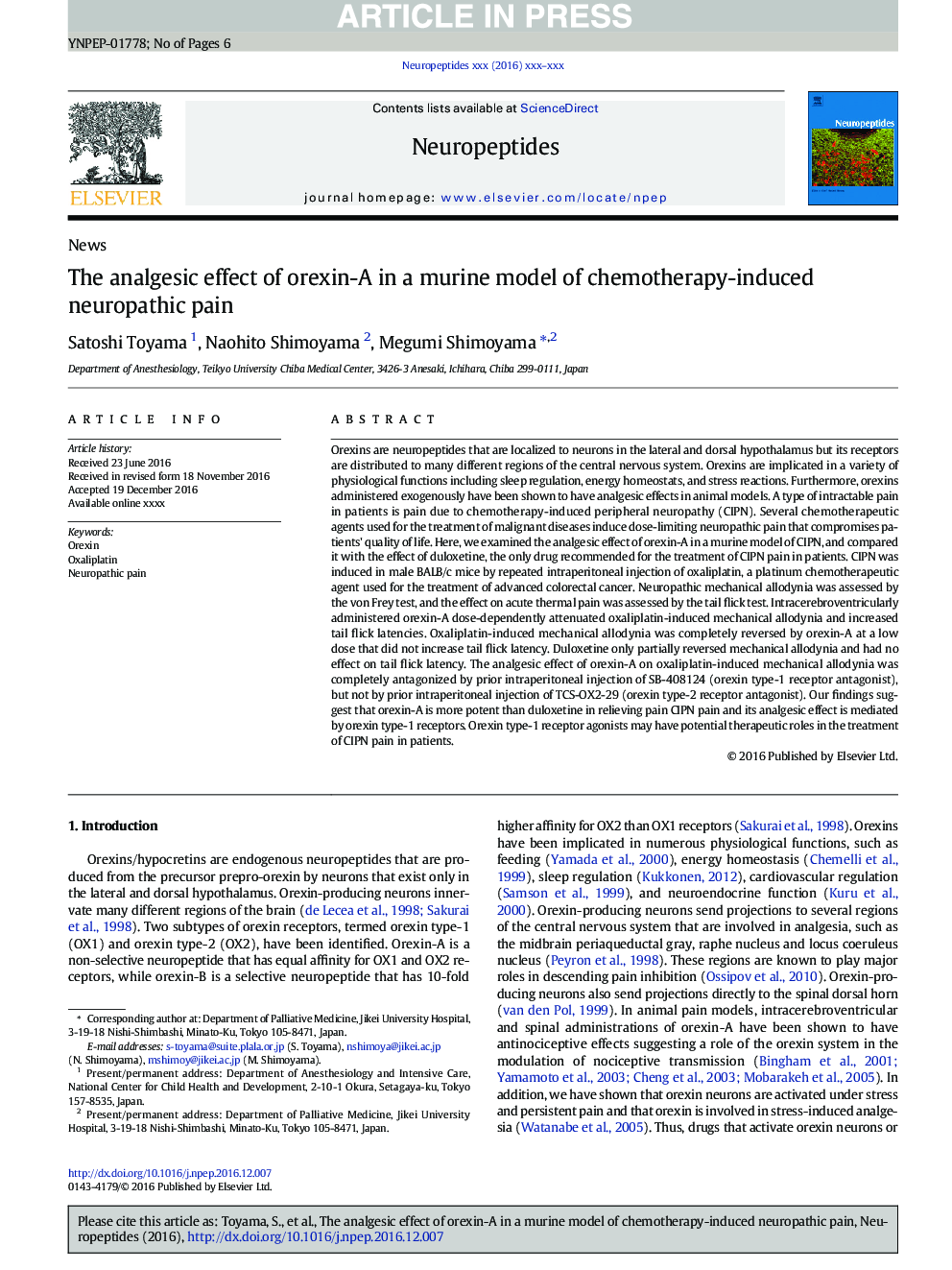| کد مقاله | کد نشریه | سال انتشار | مقاله انگلیسی | نسخه تمام متن |
|---|---|---|---|---|
| 8633815 | 1569061 | 2017 | 6 صفحه PDF | دانلود رایگان |
عنوان انگلیسی مقاله ISI
The analgesic effect of orexin-A in a murine model of chemotherapy-induced neuropathic pain
دانلود مقاله + سفارش ترجمه
دانلود مقاله ISI انگلیسی
رایگان برای ایرانیان
موضوعات مرتبط
علوم زیستی و بیوفناوری
بیوشیمی، ژنتیک و زیست شناسی مولکولی
علوم غدد
پیش نمایش صفحه اول مقاله

چکیده انگلیسی
Orexins are neuropeptides that are localized to neurons in the lateral and dorsal hypothalamus but its receptors are distributed to many different regions of the central nervous system. Orexins are implicated in a variety of physiological functions including sleep regulation, energy homeostats, and stress reactions. Furthermore, orexins administered exogenously have been shown to have analgesic effects in animal models. A type of intractable pain in patients is pain due to chemotherapy-induced peripheral neuropathy (CIPN). Several chemotherapeutic agents used for the treatment of malignant diseases induce dose-limiting neuropathic pain that compromises patients' quality of life. Here, we examined the analgesic effect of orexin-A in a murine model of CIPN, and compared it with the effect of duloxetine, the only drug recommended for the treatment of CIPN pain in patients. CIPN was induced in male BALB/c mice by repeated intraperitoneal injection of oxaliplatin, a platinum chemotherapeutic agent used for the treatment of advanced colorectal cancer. Neuropathic mechanical allodynia was assessed by the von Frey test, and the effect on acute thermal pain was assessed by the tail flick test. Intracerebroventricularly administered orexin-A dose-dependently attenuated oxaliplatin-induced mechanical allodynia and increased tail flick latencies. Oxaliplatin-induced mechanical allodynia was completely reversed by orexin-A at a low dose that did not increase tail flick latency. Duloxetine only partially reversed mechanical allodynia and had no effect on tail flick latency. The analgesic effect of orexin-A on oxaliplatin-induced mechanical allodynia was completely antagonized by prior intraperitoneal injection of SB-408124 (orexin type-1 receptor antagonist), but not by prior intraperitoneal injection of TCS-OX2-29 (orexin type-2 receptor antagonist). Our findings suggest that orexin-A is more potent than duloxetine in relieving pain CIPN pain and its analgesic effect is mediated by orexin type-1 receptors. Orexin type-1 receptor agonists may have potential therapeutic roles in the treatment of CIPN pain in patients.
ناشر
Database: Elsevier - ScienceDirect (ساینس دایرکت)
Journal: Neuropeptides - Volume 61, February 2017, Pages 95-100
Journal: Neuropeptides - Volume 61, February 2017, Pages 95-100
نویسندگان
Satoshi Toyama, Naohito Shimoyama, Megumi Shimoyama,